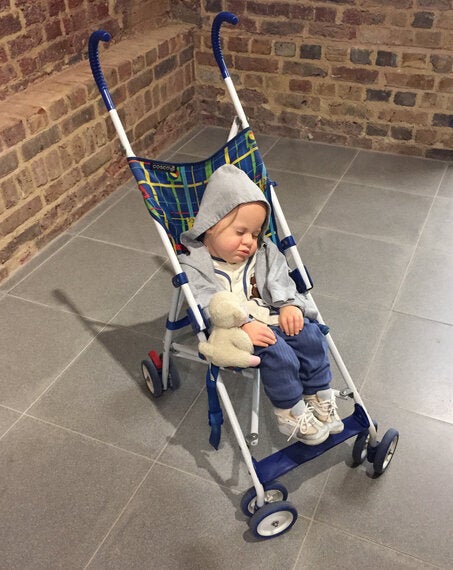
The new exhibitions at the Serpentine Galleries pairs Duane Hanson with Lynette Yiadom-Boakye, both use the human figure in their work but conceptually they could not be further apart. Hanson is one of the grand old men of the Hyper Real movement, while Yiadom-Boakye paints what appears to be real people, but are in fact creations of her imagination. Both shows are very strong for very different reasons.
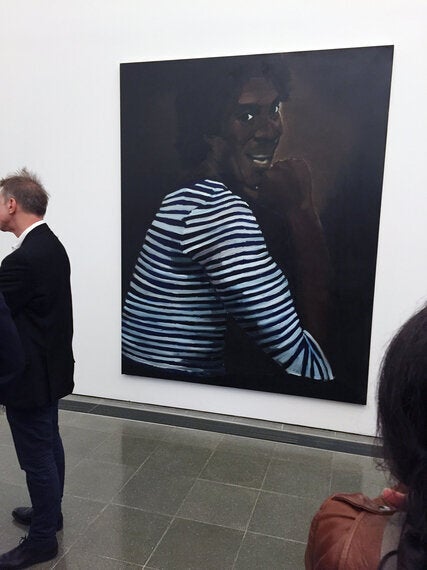
Lynette Yiadom-Boakye, Resurrect the Oracle, 2015 installation view
Yiadom-Boakye is a young artist who did not win the Turner Prize in 2013, the year she was a finalist (but then so often the outstanding artists do not) yet she stole the show at that year's Venice Biennale. Since then she has gone from strength to strength, with well received shows at the Pinchuk Art Centre, Kiev, Utah Museum of Fine Art and the Haus der Kunst, Munich. She mainly paints black people with rather darker skin than the wider audience is used to seeing. Vogue magazine once confirmed that if they place a 'person of colour' on the cover they sell less copies, but we are all people of a colour of some hue, and Yiadom-Boakye's paintings make it clear that 'black' people can also represent the universal. She recently said that 'It wasn't my intention to put black faces back in the picture. It wasn't political like that at all' but the political simply emerges from her art. She paints what she sees in her imagination and the colour of the skin of her imaginary subjects matches her own, why would it not? In Hollywood only the heterosexual white couple kissing can stand in for the universal image of love, if two black or latino people kiss it is just them, the subjects of the action, much less if lesbians or gay men of any colour kiss. Their love is not seen as universal, it is peculiar, specific. So without her intending to act in any political way, the mere presentation of black people who are not being beaten by police, dealing drugs or committing a crime gives her art a political sheen. Her subjects usually just sit around, waiting calmly, or walk through imaginary landscapes. They are so well painted that we want to be in the picture too, they invite us in, they make us wonder who these people are, and they look so good.
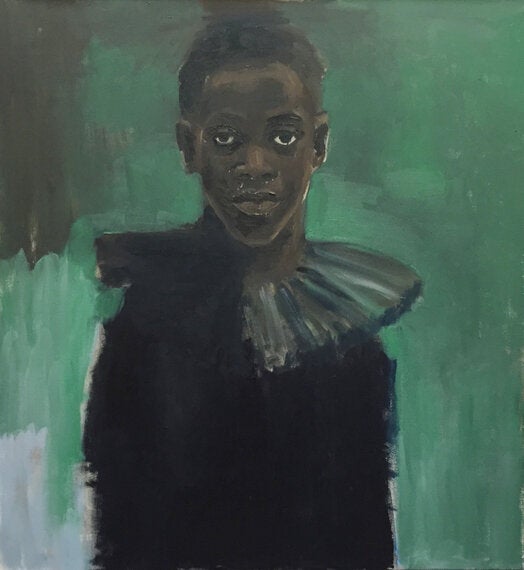
The young man in A Passion Like No Other (2012) above, wears a ruff of sorts, he looks dashing and his gaze is directed back at the viewer or Yiadom-Boakye. This is a trope she often uses, her fictive friends confront us, ask us why we are looking at them, yet they were never real. Whenever I see these works I think of any great novel, where the lead character is obviously a construct. As a reader we are happy to imagine characters as we please, yet in the visual arts when we see figuration, we want it to represent some specific sitter. This is the domain of Lucien Freud or even Hanson, where they try very hard to present the sitter as they were. With Yiadom-Boakye we can luxuriate in the fictive red robes that her men wear as in Any Number of Preoccupations (2010) below, or other variations on the John Singer Sargent swagger painting of Dr Samuel Jean Pozzi at Home (1881). She mines art history the way Hanson mines Walmart for subject matter.
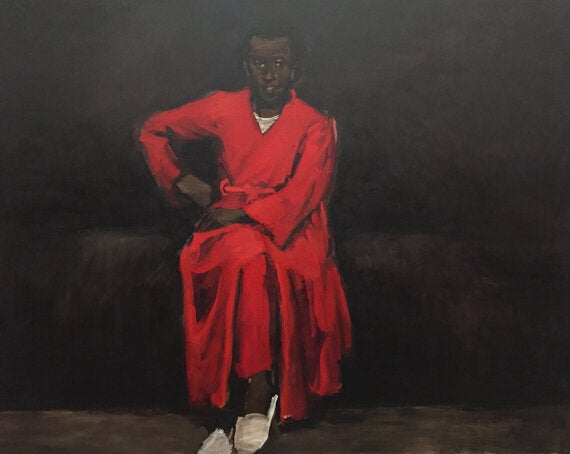
Recently Georg Baselitz (for the second time) threw serious shade on women artists and painters in particular stating "If women are ambitious enough to succeed, they can do so, thank you very much. But up until now, they have failed to prove that they want to. Normally, women sell themselves well, but not as painters." Grumpy old Caucasian men exist in European and American culture and they always seem to be oblivious to their own white privilege, and how the market is structured to appeal to other old rich white collectors who also happen to be men. It has nothing to do with the quality of the work made by women, or 'people of colour' that they have been structurally placed in a secondary position in the market. What Baselitz and any others who think women can't paint need to do, is come see this show (and keep quite) or the work of Marlene Dumas. Yiadom-Boakye's Coterie of Questions (2015) below, features a handsome young man in a pale t-shirt and it knocks the socks off Baselitz' recent work show at this Venice Biennale.
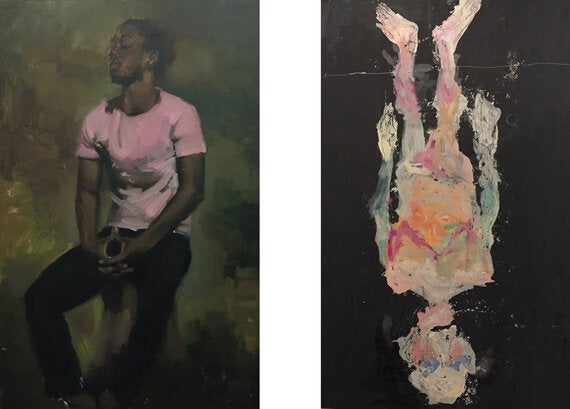
Yaidom-Boakye left, Baselitz right
Hanson has made no such claims about men and women in sculpture perhaps because he knows how unique each of us is. He picks his subject matter from the underclass of America and he makes them look pretty darn real. His work is far removed from the wax works of Madame Tussards. Hanson aims for his work to be as real as possible and yet age has not been kind to his sculptures.
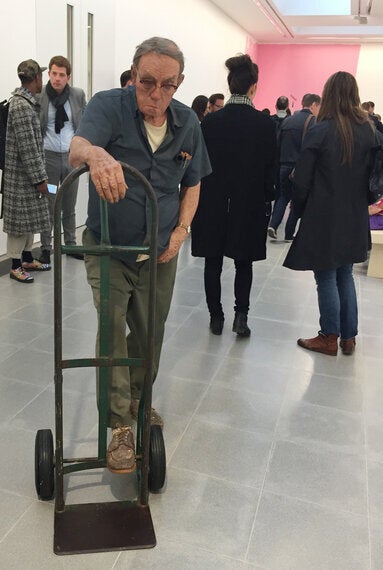
Many of the works from the 1970s and 80s show a lot of wear and tear, they look dusty and possibly dirty in a way he did not originally intend. And then there are the wigs, they look like they have been put through too many wash cycles and were not of very good quality in the first place. Rupaul or any drag contemporaries have a much better variety of false hair at hand. But Hanson has a way of working and surprising the viewer that is not found at Tussards, these people really do look like archetype Americans. There is the old couple on a bench, the man with a comb over his wife with varicose veins, or the working Man with Hand Cart (1975) above, who looks like he has just dropped off one of the other sculptures, or the cleaner Queenie II (1988) below, who might just have stopped to look back at us, looking at her do her rounds of the Serpentine.

Being Americans almost everyone is over weight and even the Baby in Stroller (1995) seen at the top of the page, looks like she too will succumb to a life of salty fast and over sugared food. The child looks like many who have been momentarily left by their parents to attend to a phone call or some errand, she sleeps comforted by her stuffed animal.
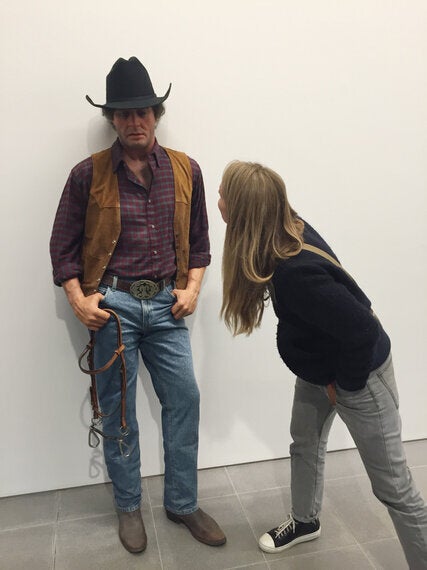
Only the Cowboy (1984/1995) above, still has the freshness of the newly made about him and people continued to get as close as possible to view him. Yet I can't help think that Ron Mueck would have been a better match with Yiadom-Boakye. He too takes the figure out of the expected by creating fictions like his giant sized babies or tiny old people. He uses the wax worker's skills to throw us out of our comfort zone. In one work, a newly born baby sits on the mother's stomach, the umbilical cord still attached to it and her. The baby glistens and she looks towards it and we have to turn away from her open legs. It seems odd that we are watching her in what should be a private moment, yet it is only a fiction. Mueck's work is not jokey like much of Hanson's, whether he intends it to be or not. For me the true gem of Hanson's show, a piece I did not know, was one of his earliest called Trash (1967). Seen below, we are presented with a trash can full of stuff including a suffocated baby. The child is not hyper real, it is fictional, an art work, and it looks very dead, and in that moment it becomes universal.

2 June - 13 September
Lynette Yiadom-Boakye: Verses After Dusk
Serpentine Gallery
Duane Hanson
Serpentine Sackler Gallery
All photos: author's own
